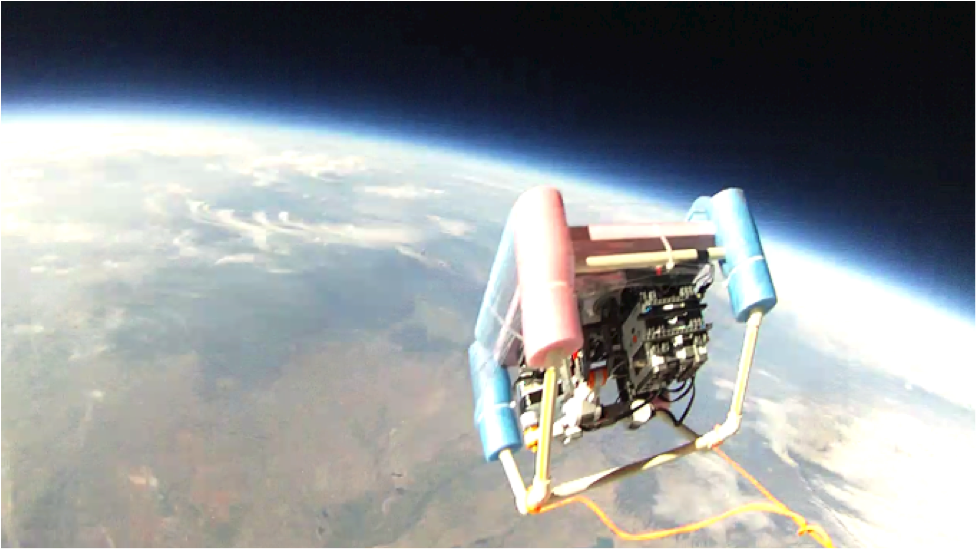Goals of the project
The High Altitude Research Platform (HARP) was developed to allow pre-freshman STEM majors in a summer bridge program an opportunity to design and construct a near-space research craft, and participate in a comprehensive experience that simulates large-scale multidisciplinary research endeavors similar to the space shuttle missions. Under the leadership of Dr. Lycurgus Muldrow, HARP students launch original research projects into “near space” conditions using weather balloons and recover them. The research and engineering teams that are formed in HARP include the Design, Launch and Recovery team, the Robotics team, and the Research teams. The Design, Launch and Recovery team is responsible for designing and building an original research craft, then launching and recovering the craft. The robotics team is responsible for designing instrumentation to be placed in the craft that manipulates the research materials that will be studied at high altitudes. Finally the research teams send into near space conditions original, student-based, research projects housed in the craft and manipulated by the robotic instruments.
Nature of the Collaboration
Representatives from the Robotics and the Design Launch and Recovery teams communicate regularly with the Research teams to ensure that the completed craft was constructed within the required specifications
Skills
The skills utilized include the design and manufacture of the craft; the construction and program coding for the robot; and various skills needed in research development.
Tools
To conduct the HARP project students used: high altitude balloons; 3D printers and basic building supplies to make the craft; robotic kits to facilitate onboard experiments; a software program that allow students to predict where the balloon’s payload would land; a GPS tracking system that allow students to track the balloon in real time and recover its payload after landing; video cameras that record the flight; and a series of other instruments that record altitude, atmospheric pressure, humidity and temperature.
Process
In recent years high altitude ballooning has been utilized undergraduate curricula and primarily used in upper level, undergraduate engineering courses. Morehouse College has modified this curriculum and created a comprehensive experience suitable for first-year science majors in a summer program. This was accomplished by using scientific kits that could be mastered by pre-freshmen during a summer program.
Milestones
Three different research crafts were created and sent into near space conditions, approximately 100,000 feet. Fifteen different research projects were conducted over the three year period, with videos and pictures taken of various aspects of each launch. In total 110 students participated in this project over a three year period.
Challenges encountered
Challenges faced were related to launching the craft in the forested areas of Georgia, this was overcome by launching the craft in Wyoming.
Major outcomes
Student outcome data derived from assessment instruments strongly indicated that the pre-freshman summer program experience with the HARP project enhanced cognitive and non-cognitive skills, as well as student motivation to succeed. Specifically, students (n=110) were asked to rank their belief from 1 to 5, with one being strongly disagree and 5 strongly agree, relative to eight self-assessment statements about understanding the interdisciplinary nature of STEM, and improving specific cognitive and non-cognitive skills. The students strongly agreed with an overall average score of 4.4 to the eight statements.
Innovations, impact and successes
Students presented their work and research findings at local conferences, a maker-fair and the Emerging Research National Conference for undergraduate students sponsored by the National Science Foundation and the American Association for the Advancement of Science.
A description of this high altitude research platform has been featured in a one-hour long, professionally produced documentary airing on CAU-TV, a PBS cable channel in Atlanta, Georgia. This documentary has also won Honorable Mention and a Gold Award (www.marcomawards.com) from Marcom, an international creative competition that recognizes outstanding achievement by communication professionals. Finally the details of this HARP program and been submitted for peer review publication.
 Lycurgus Muldrow
Lycurgus Muldrow
 wolves
wolves
 juana.mendenhall
juana.mendenhall

